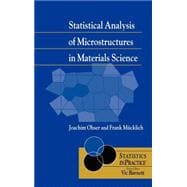
What is included with this book?
Joachim Ohser holds a Chair at University of Applied Sciences, Darmstadt, Germany, where he is a professor in the field of image processing. He has long experience with characterization and geometric modelling of microstructures. Since 1999 he heads the working group on quantitative microstructural analysis of the German Materials Society. His research focuses on stochastic and discrete geometry, image analysis and simulation of materials properties.
| Dedication to Gunter Bach | ix | ||||
| Preface | xi | ||||
| Series Preface | xiii | ||||
| Acknowledgements | xv | ||||
|
xvii | ||||
|
xxi | ||||
|
1 | (8) | |||
|
1 | (1) | |||
|
1 | (4) | |||
|
5 | (4) | |||
|
9 | (48) | |||
|
10 | (15) | |||
|
10 | (1) | |||
|
11 | (2) | |||
|
13 | (4) | |||
|
17 | (8) | |||
|
25 | (9) | |||
|
27 | (3) | |||
|
30 | (1) | |||
|
31 | (3) | |||
|
34 | (4) | |||
|
34 | (3) | |||
|
37 | (1) | |||
|
38 | (8) | |||
|
46 | (11) | |||
|
47 | (1) | |||
|
48 | (3) | |||
|
51 | (6) | |||
|
57 | (50) | |||
|
61 | (6) | |||
|
67 | (18) | |||
|
70 | (3) | |||
|
73 | (2) | |||
|
75 | (3) | |||
|
78 | (2) | |||
|
80 | (5) | |||
|
85 | (11) | |||
|
86 | (2) | |||
|
88 | (1) | |||
|
88 | (6) | |||
|
94 | (2) | |||
|
96 | (1) | |||
|
96 | (11) | |||
|
97 | (3) | |||
|
100 | (2) | |||
|
102 | (5) | |||
|
107 | (34) | |||
|
109 | (15) | |||
|
113 | (1) | |||
|
114 | (3) | |||
|
117 | (4) | |||
|
121 | (3) | |||
|
124 | (17) | |||
|
126 | (1) | |||
|
127 | (2) | |||
|
129 | (4) | |||
|
133 | (2) | |||
|
135 | (6) | |||
|
141 | (22) | |||
|
142 | (10) | |||
|
142 | (3) | |||
|
145 | (5) | |||
|
150 | (2) | |||
|
152 | (11) | |||
|
152 | (2) | |||
|
154 | (2) | |||
|
156 | (5) | |||
|
161 | (2) | |||
|
163 | (36) | |||
|
166 | (12) | |||
|
167 | (9) | |||
|
176 | (2) | |||
|
178 | (12) | |||
|
181 | (6) | |||
|
187 | (3) | |||
|
190 | (9) | |||
|
191 | (2) | |||
|
193 | (6) | |||
|
199 | (38) | |||
|
201 | (1) | |||
|
202 | (8) | |||
|
202 | (2) | |||
|
204 | (6) | |||
|
210 | (4) | |||
|
214 | (8) | |||
|
214 | (1) | |||
|
215 | (3) | |||
|
218 | (4) | |||
|
222 | (15) | |||
|
224 | (3) | |||
|
227 | (10) | |||
|
237 | (26) | |||
|
239 | (15) | |||
|
242 | (3) | |||
|
245 | (9) | |||
|
254 | (9) | |||
|
263 | (50) | |||
|
270 | (17) | |||
|
271 | (3) | |||
|
274 | (5) | |||
|
279 | (3) | |||
|
282 | (3) | |||
|
285 | (1) | |||
|
286 | (1) | |||
|
287 | (9) | |||
|
288 | (5) | |||
|
293 | (3) | |||
|
296 | (7) | |||
|
297 | (2) | |||
|
299 | (4) | |||
|
303 | (10) | |||
|
303 | (5) | |||
|
308 | (2) | |||
|
310 | (1) | |||
|
311 | (2) | |||
|
313 | (38) | |||
|
317 | ||||
|
317 | (3) | |||
|
320 | ||||
|
223 | (103) | |||
|
326 | (12) | |||
|
328 | (4) | |||
|
332 | (6) | |||
|
338 | (9) | |||
|
339 | (6) | |||
|
345 | (2) | |||
|
347 | (4) | |||
| Appendix A Characteristics of Geometric Objects | 351 | (8) | |||
| Appendix B Software Utilities | 359 | (4) | |||
| References | 363 | (12) | |||
| Index | 375 |
The New copy of this book will include any supplemental materials advertised. Please check the title of the book to determine if it should include any access cards, study guides, lab manuals, CDs, etc.
The Used, Rental and eBook copies of this book are not guaranteed to include any supplemental materials. Typically, only the book itself is included. This is true even if the title states it includes any access cards, study guides, lab manuals, CDs, etc.